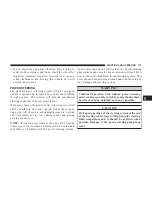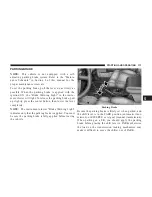
counteracting the over/under steer condition. Engine
power may also be reduced to help the vehicle maintain
the desired path.
ESP uses sensors in the vehicle to determine the vehicle
path intended by the driver and compares it to the actual
path of the vehicle. When the actual path does not match
the intended path, ESP applies the brake of the appropri-
ate wheel to assist in counteracting the oversteer or
understeer condition.
•
Oversteer - when the vehicle is turning more than
appropriate for the steering wheel position.
•
Understeer - when the vehicle is turning less than
appropriate for the steering wheel position.
The “ESP/TCS Indicator Light” (located in the instru-
ment cluster), starts to flash as soon as the tires lose
traction and the ESP system becomes active. The “ESP/
TCS Indicator Light” also flashes when TCS is active. If
the “ESP/TCS Indicator Light” begins to flash during
acceleration, ease up on the accelerator and apply as little
throttle as possible. Be sure to adapt your speed and
driving to the prevailing road conditions.
WARNING!
The Electronic Stability Program (ESP) cannot pre-
vent the natural laws of physics from acting on the
vehicle, nor can it increase the traction afforded by
prevailing road conditions. The ESP cannot prevent
accidents, including those resulting from excessive
speed in turns, driving on very slippery surfaces, or
hydroplaning. Only a safe, attentive, and skillful
driver can prevent accidents. The capabilities of an
ESP-equipped vehicle must never be exploited in a
reckless or dangerous manner which could jeopar-
dize the user’s safety or the safety of others.
5
STARTING AND OPERATING
323
Summary of Contents for 2009 Wrangler
Page 1: ......
Page 4: ......
Page 9: ...1 INTRODUCTION 7...
Page 78: ......
Page 196: ......
Page 201: ...INSTRUMENT CLUSTER 4 UNDERSTANDING YOUR INSTRUMENT PANEL 199...
Page 340: ...338 STARTING AND OPERATING...
Page 382: ......
Page 394: ......
Page 446: ......
Page 477: ...INDEX 10...
Page 496: ......
















































